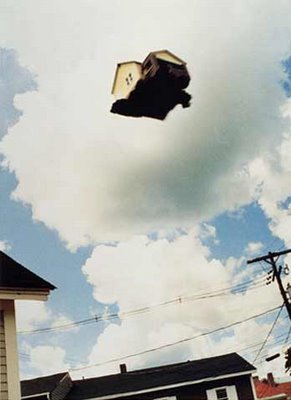
Friday Hope Blogging concentrates enough on new technology that I’m sometimes afraid people will mistake me for a Sensible Technocrat…the kind of person who thinks that a few new inventions, coupled with some retooling of current technology, will allow us to live indefinitely in the style to which we’ve become accustomed (long live the new flesh!)
Actually, my viewpoint is quite a bit different. If technology is normative – and it assuredly is - then it’s logical to assume that new technology can lead to new behavior and new thinking. (Whether it’s logical to assume that this new behavior and new thinking will be sufficent is another matter, of course.)
As a very simplistic example, take the design of soda cans. When I was a kid, the streets and beaches were littered with little metal rings attached to dangerously sharp, curled metal tongues. This was rightfully considered a problem, and it was addressed not by convincing people to stop discarding pull-rings, but by redesigning how soda cans open. As a fringe benefit, the new appearance of soda cans – and the fact that they required different steps to open – communicated a message, however modest, about littering.
With that in mind, consider this new study, which suggests that scaring people is not a reliable way of getting them to change their behavior:
[T]he most effective strategies were to prompt practice, set specific goals, generate self-talk, agree a behavioural contract and prompt review of behavioural goals. The two least effective strategies involved arousing fear and causing people to regret if they acted in a particular fashion.
Part of what “prompts practice,” as the soda-can example demonstrates, is design and technology. An article from a couple weeks ago – which I’ve misplaced – talks about how the mere fact of owning a car makes people more inclined to use it, regardless of whether that choice is actually in the owner’s best interests at a given moment. It may
feel like rational choice, but isn’t; it’s reflex. (An
article on how drug samples influence prescription trends underscores this point.)
Since design affects how people think, and constrains how they act, it makes sense to change it. San Francisco has taken a respectable step in this direction by building a shopping mall with
no parking lots:
"No new parking was built to accommodate the 25 million people a year expected to visit the mall, which has tripled in size (through the addition of 1 million square feet of retail and office space). The decision not to add parking is in keeping with the city's "transit first" policy, which encourages the use of public transportation."
And Toyota is putting
eco-indicators in new cars, which will allow drivers to see how driving choices affect gas mileage. As Treehugger says:
When you stop to think about it, it's pretty obvious what causes good or bad fuel economy, but that's exactly the problem: Most people don't stop to think about it, or at least not while they are driving. They need constant reminders.
Which reminds me that
WorldChanging has a terrific article on deglamorizing consumer choice:
Sometimes, we need a hole in our wall, so we buy a drill. But we don't need the drill, we need the hole. A system that offered the object on demand when we needed results would provide us with the hole but eliminate having a dusty drill sitting in our toolbox for 20 years….
It's one thing to recognize that what we desire is an end result, but another entirely to release our longing to be surrounded by all the means that take us to these ends. It's a deep shift that will lead us to long for an outcome, not an object.
Optimal change requires ideas, obviously, and lots of them. Unfortunately, in wealthier countries, a lot of our problem-solving is top-down, and involves a pointless intensification of comforts we already enjoy. People in more (obviously) desperate circumstances tend to be a lot more innovative. Subtopia’s discussion of
squatter mimicry describes:
[A] future world where the squatters and refugees will be the leaders of a self-sustainable revolution, a bottom-feeders' guide to survival and the retooling of cities on a global scale. It may be those very same principles of self-mobilization and scavenge that will save urbanization from itself.
This ties in with WorldChanging’s feature on Brazil’s
Catalytic Communities program:
CatComm's online Community Solutions Database (CSD) offers public, freely available information (in three languages) on community-initiated solutions to local challenges, which may include everything from sanitation to unemployment to HIV. The CSD accepts submissions from community groups who have documented their work as a means of sharing their solutions with others who might use similar strategies to deal with issues in their own communities.
Obviously, these efforts require infrastructure, which is why projects like
Green WiFi are so valuable.
Speaking of community groups, I enjoyed Amanda Griscom Little’s interview with
Majora Carter, the remarkable founder of Sustainable South Bronx:
[W]e recruit folks, almost exclusively from the neighborhood. I'd say 95 percent have been on public assistance, and most just received their GEDs. The ages range from about 20 to 45 and we train them in everything from landscaping and green-roof installation to brownfield remediation. Already we've graduated almost three dozen people from the program, and most have paying jobs.
It's amazing how much one person can do.
Defense Tech describes how the British comedian Mark Thomas shut down Internet arms dealers:
[H]e helped a bunch of teenaged schoolgirls set up an online arms dealership. Before long, they were pricing out tanks, negotiating for grenade launchers, and -- in his words -- buying up stun batons and other "equipment intended for torture or ill-treatment."
"Mark Thomas, the stand-up comedian, has done more to expose illegal arms deals than the Ministry of Defence, the Export Control Organisation and HM Revenue and Customs put together," the Guardian proclaims, "simply by searching the internet and the trade press and attending the arms fairs the British government hosts."
And an
NYT article describes how a woman in Montclair, NJ is using Google maps to increase awareness of destructive development patterns:
“Maybe something like this will give people pause,” said Ms. George, 39, in her office at her gracious 100-year-old home. “Knowing you’re having your house on the teardown map, knowing it will be part of this trend, I don’t think it has a positive implication.”
Demolished Buildings of Portland is a somewhat similar site…well worth looking at.
In other news, specially designed
paving stones could collect and purify rainwater:
Roads, driveways, pathways and the like make up 60 per cent of impervious urban surfaces. The run-off from them causes flooding and pollutes waterways. Professor Beecham says until now, harvesting rainwater from them has proved more difficult than from roofs. His team is developing a system in which porous concrete pavers allows run-off to seep into underground tanks made of galvanised metal or a flexible plastic lining filled with gravel.
Twenty percent of Guatemala’s debt to the United States has been
forgiven in return for forest conservation:
"The areas protected in this agreement lie in the heart of Mayan civilization, and they are home to jaguars, scarlet macaws, harpy eagles, and countless other species," said TNC President Steven J. McCormick.
Well and good…but the fact is,
we owe them, not vice versa.
A
byproduct of organic and recycled paper can be used as compost, and may have the fringe benefit of reducing plant disease:
The ecological benefits of this are obvious: less fungicide has to be applied to plants, less peat is required thus preserving peat bogs, and green waste and paper waste that would otherwise be land-filled is recycled.
This seems a bit too good to be true, but what the heck:
A newly-patented eating, breathing membrane that cleans waste water and sewage has won an invention award….Dr Taylor, an ANSTO microbiologist, said the membrane literally ate waste matter and breathed air, and was self-perpetuating.
Glenn Reynolds has yet another option for eternal life, and all he has to do is act naturally! The rest of us can content ourselves with eating
curry to stave off amyloid plaque diseases:
UCLA/VA researchers found that curcumin -- a chemical found in curry and turmeric -- may help the immune system clear the brain of amyloid beta, which form the plaques found in Alzheimer's disease.
Coudal alerts me to an amazing site called
Art of the Photogravure. You’ll need to set aside a couple of days to browse it properly, but in the meantime, here’s Prescott Adamson’s
Mist Steam and Smoke (1904):
 Pruned
Pruned investigates Faraday Waves, and links to an incredible film called
Fingers and Holes in a Shaken Cornstarch Solution. It also invites you to consider the heartstopping beauty of
astrogeology:

You might also enjoy
Doodles, Drafts and Designs: Industrial Drawings from the Smithsonian. And
Photomicrography. But if you get seasick easily, you'll probably want to avoid these dizzying 360-degree views of
wind tunnels.
(Photo by
Peter Garfield, from his series “Falling Houses.”)


































